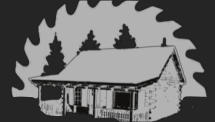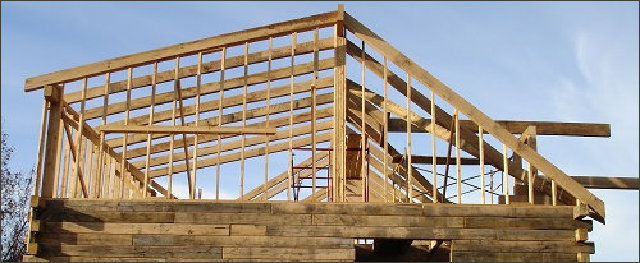




Common Terminology
What the heck are we talking about?
Anchor Bolt: A steel bolt, which is embedded in the concrete foundation of a structure and used
to anchor the sill plate.
Angle Brace: Any timber bracing a corner at an angle across that corner. Also called a knee
brace.
Angle Iron: An L shaped length of steel frequently used to support masonry over a window or
door opening.
Base Course: The first or bottom course of masonry blocks, or logs in a wall (sill logs).
Beam: A main horizontal member used to support vertical loads.
Bearing Wall: A wall supporting a vertical load.
Bird’s Mouth (Cut): A V shaped notch cut into the base of a rafter that allows the rafter to sit flat
on the wall or the plate.
Board and Batten siding: is an exterior treatment of vertical boards ¾” thick and 5-8” wide with
3” battens covering the seams.
Buck: A vertical board fastened to the ends of log sections at the window or door openings to
secure them in place and to which the window or door jamb is fastened. Bucking- A frame
around window openings to allow expansion and contraction of the log walls around the
windows without compromising the windows.
Butt Joint: A joint made by fastening two logs together without overlap. The two members are
square cut and joined at the flat surface.
Butt and pass overlap: The butt and pass style method of building cabins is a construction
technique which uses tightly-pinned corners, to remove the need for any notching, to join the
logs together.
Cantilever: A structural member supported on one end but extending beyond its support on the
other end.
Caulking: Material used to seal the joints between logs or between windows and walls, doors
and walls, etc.
Chamfering: This is the process of planning the edges of the log removing the corner to create a
valley to hold the chink.
Checking: A "check" is a crack on the surface of the wood caused by the outside of a timber
shrinking as it seasons. Checks may extend to the pith and follow the grain. Checks occur more
frequently at the ends of lumber because of the more rapid drying in these locations.
Chinking: Either the material or the process by which gaps between logs are filled. a pliable
compound used to fill the chamfered spaces between the logs.
Collar Tie/Collar Beam: A horizontal timber, which ties two opposite pairs of rafters together
near the middle to reduce sagging or spreading.
Cope: A notch in a log that is cut and rounded to fit over another log.
Corbel: A short horizontal timber supporting a girder.
Countersink: To cause the head of a bolt or spike to be below the surface of the wood into which
it is embedded.
Course of Logs: One layer of logs around the house perimeter.
Counter Sink: To allow the head of a bolt or screw, when placed in the hole, to sit flush with or
below the surface of the surrounding material
Cove: A shallow, round shaped groove cut into the underside of a log.
Crown Post: A central vertical post that connects the collar tie to the bent plate.
Dead Load: Weight that a structural member is supporting by the weight of the structure. Does
not include snow, wind, furniture, people, cars etc…
Diagonal: Reaching from corner to opposite corner at an angle.
Dormer: A window or a smaller roofed area protruding from a sloping roof.
Dowel: Wooden peg used to hold two pieces of wood together.
Eave: The lower or bottom edge of a roof that projects beyond the face of the walls.
Eave Soffit: The underside of the eave.
Expansion Joint: A joint, which permits expansion without doing damage to the structure.
Fascia: The trim board that usually covers the exposed ends of rafters or overhang.
Flashing: Weatherproof stripping used to seal joints between masonry and wood framing or log
work, and masonry and roofing.
Floor Joists: The heavy beams that support the flooring.
Framing: The network of lumber in a building that will be covered by finish material.
Gable: The triangular portion at the top of a wall enclosed by the roof at the ends of the house.
Gable End: The wall in a house that has a gable roof.
Gable Roof: A sloping roof that forms an ‘A’ shape.
Gambrel Roof: A roof with one slope steeper than the other.
Girder: A horizontal structural member that supports joists.
Girt: A major horizontal timber that connects posts. provide lateral support to the wall panel,
primarily, to resist wind loads. May also be known as a sheeting rail.
Grain: Direction of cellular arrangement in wood.
Half-Lap: A type of joint in which two timbers are lapped or let into one another.
Header: Horizontal members between vertical posts which add support.
Heart Wood: The wood in a tree, which extends from the middle of the trunk outward towards
the Sapwood. The older harder nonliving central wood of trees that is usually darker, denser,
less permeable, and more durable than the surrounding sapwood.
Hip: The sloping ridge of a roof formed by two intersecting roof slopes.
Hip-Rafter: The rafter that forms the hip of a roof.
I-Beam: A steel beam with a cross section that makes it resemble the letter I.
Jack Rafter: A short rafter that extends from the roof ridge to a valley rafter or from the wall
plate to a hip rafter.
Joinery: Connecting timbers by means of woodworking joints.
Joint: Any place where two or more timbers meet.
Joists: Horizontal, parallel timbers used to support the floor, ceiling, or roof.
Joist Hanger: A metal support for the ends of joists.
Kerf: The groove left in a piece of wood by a saw cut.
King Post: A vertical support that transfers weight from the ridge beam to the end walls or the
joists.
Knee Brace: A small timber that is framed diagonally between a post and beam.
Knee wall: A knee wall is a short wall, typically under three feet in height, used to support the
rafters in timber roof construction.
Lag Screw: A heavy screw for wood with a bolt head.
Lateral Groove: A longitudinal groove cut into the underside of a log enabling that log to fit over
the top of another log.
Load Bearing: Carrying the weight of a structure.
Loft: The second floor in a home where the roof forms both its ceiling and walls usually
associated with houses possessing a cathedral ceiling.
Mortise: A square or rectangular slot cut into a log, timber, or board into which another
member, usually called a tenon, will fit.
Mortise and Tenon Joint: A joint in which a projection (tenon) of one timber is inserted into a
slot (mortise) of another timber.
Moisture Content: Percentage by weight of water in wood.
Newel: The bottom post to which a stair railing is attached. Also post supporting sections of
railings.
Notch: A recess cut into a log to accept another log intersecting it at an angle.
• Blind Notch: A notch that does not extend completely through a log.
• Boxed Lapped Notch: A notch cut squarely into part of each timber
• Dovetail Notch: Log ends cut into a fan appearance resembling a dove’s spread tail.
• Half Dovetail Notch: Log end where one side only is sloped.
• Mitered Lapped Notch: Notch that has a 45-degree slope on the sides of the square notch.
• Round Notch: A notch in which the profile of the log exhibits the shape of a partial circle on the
underside.
• Round Sheep’s Head Notch: Same as a Sheep’s Head Notch except that the outer cuts retain a
round shape.
• Saddle Notch: Notch that is triangular in profile.
• Sheep’s Head Notch: A notch with sloped sides partially cut out of each log.
• Square Notch: Has the appearance of a round notch on the exterior but inside has a square
interlocking lap.
Notching: The art of cutting a notch into logs.
Outrigger Beam: A log which sites atop a cantilevered logs on the eave walls and is parallel to
and extends out beyond the plate logs. It is to this beam that the roof framing is attached.
Overhang: That part of the roof that extends beyond the outside wall.
Peg: A wooden dowel of oak, locust or other woods.
Purloins: span between the rafters. They create a horizontal “diaphragm” that supports the
weight of your building’s roof deck- whatever material you use for the roofing itself. They also
help make the entire roof structure more rigid. Because they add mid-span support, purloins
allow longer spans enabling you to create wider buildings.
Piece-en-Piece: A style of building in which vertical support posts form the main structure of a
home with short lengths of logs forming the wall panels in sections between the posts.
Pitch: The slope or angle of a roof.
Plate-Log: The log at the top of the wall that supports the roof.
Post and Beam: A style of building that uses vertical posts supporting horizontal members and
beams.
Rafter: A structural member, usually dimensional lumber that supports a roof.
Rafter Truss: A triangle of two rafters and a horizontal brace. Several of these make up a roof
sub-structure.
Ridge Beam: A horizontal timber at the peak of the roof to which rafters are attached. Also
called a ridge board, ridge piece, or ridgepole.
Roof Pitch: Inches of rise per 12” of roof run.
Roof Truss: A network of structural members that form a rigid support for the roof.
Round of Logs: One layer of logs around the entire perimeter of the house.
Saddle: The lower cut in a notch and saddle joint. The log is cut on an angle on each side so that
the surface almost comes to a point at the top of the log.
Sapwood: The outer layer of wood in a tree that is nearest to the bark.
Scarfed: A cut at a long angle in the direction of the timber.
Scribe: The process of cutting one log to match the contours of another for a tight log-to-log fit.
Scribe-Fit: A building featuring tight log-to-log joinery.
Screw Jack: A device that may be adjusted to allow for the settlement in log walls.
Settling: Loss of wall height by shrinkage and compression.
Shed Roof: A sloping roof of a single plane.
Ship lap: is a type of wooden board used commonly as exterior siding in the construction of
residences, barns, sheds,and outbuildings. It is either rough-sawn 1" or milled ¾” thickness
and between 3" and 10" wide with a 3/8" - 1/2" rabbet on opposite sides of each end. The rabbet
allows the boards to overlap in this area. The profile of each board partially overlaps that of the
board next to it creating a channel that gives shadow line effects, provides excellent weather
protection and allows for dimensional movement
Sill Log: The base log that sits upon the foundation.
Sills: Horizontal members that form the base of window and door openings.
Soffit: the underside of the roof overhang.
Splice: A joint of two logs end to end.
Spline: A narrow wooden strip placed into grooves cut into two adjoining surfaces of a log wall.
Taper: The amount of change in the diameter of a log from the butt end to the top end.
Timber framing: is a style of construction which uses heavier framing elements than
modern stick framing, which uses dimensional lumber. The timbers were originally joined
together with joinery without nails. Modern timber framing has been growing in popularity in
the United States since the 1970s. Modern timber framing includes brackets and hangers.
Timber-Loc Screws: A heavy duty wood screw for applications such as attaching rafter or
trusses to the top plate, landscape timbers, fences, decks, headers, stair stringers and more.
Replaces 3/8" lag screws. There is no need to pre-drill with Timber-Loc. Its sharp point and
aggressive threads zip right in to the densest woods.
Truss: Structural members assembled into a rigid frame.
Through-Bolting: Threaded rod of various length used as a tensioning device in log walls, post
and beam joinery and some timber frames.



Schutt Log Homes
& Mill Works



Common Terminology

What the heck are we talking about?
Anchor Bolt: A steel bolt, which is embedded in the concrete
foundation of a structure and used to anchor the sill plate.
Angle Brace: Any timber bracing a corner at an angle across
that corner. Also called a knee brace.
Angle Iron: An L shaped length of steel frequently used to
support masonry over a window or door opening.
Base Course: The first or bottom course of masonry blocks, or
logs in a wall (sill logs).
Beam: A main horizontal member used to support vertical
loads.
Bearing Wall: A wall supporting a vertical load.
Bird’s Mouth (Cut): A V shaped notch cut into the base of a
rafter that allows the rafter to sit flat on the wall or the plate.
Board and Batten siding: is an exterior treatment of vertical
boards ¾” thick and 5-8” wide with 3” battens covering the
seams.
Buck: A vertical board fastened to the ends of log sections at
the window or door openings to secure them in place and to
which the window or door jamb is fastened. Bucking- A frame
around window openings to allow expansion and contraction
of the log walls around the windows without compromising the
windows.
Butt Joint: A joint made by fastening two logs together without
overlap. The two members are square cut and joined at the flat
surface.
Butt and pass overlap: The butt and pass style method of
building cabins is a construction technique which uses tightly-
pinned corners, to remove the need for any notching, to join
the logs together.
Cantilever: A structural member supported on one end but
extending beyond its support on the other end.
Caulking: Material used to seal the joints between logs or
between windows and walls, doors and walls, etc.
Chamfering: This is the process of planning the edges of the log
removing the corner to create a valley to hold the chink.
Checking: A "check" is a crack on the surface of the wood
caused by the outside of a timber shrinking as it seasons.
Checks may extend to the pith and follow the grain. Checks
occur more frequently at the ends of lumber because of the
more rapid drying in these locations.
Chinking: Either the material or the process by which gaps
between logs are filled. a pliable compound used to fill the
chamfered spaces between the logs.
Collar Tie/Collar Beam: A horizontal timber, which ties two
opposite pairs of rafters together near the middle to reduce
sagging or spreading.
Cope: A notch in a log that is cut and rounded to fit over
another log.
Corbel: A short horizontal timber supporting a girder.
Countersink: To cause the head of a bolt or spike to be below
the surface of the wood into which it is embedded.
Course of Logs: One layer of logs around the house perimeter.
Counter Sink: To allow the head of a bolt or screw, when
placed in the hole, to sit flush with or below the surface of the
surrounding material
Cove: A shallow, round shaped groove cut into the underside of
a log.
Crown Post: A central vertical post that connects the collar tie
to the bent plate.
Dead Load: Weight that a structural member is supporting by
the weight of the structure. Does not include snow, wind,
furniture, people, cars etc…
Diagonal: Reaching from corner to opposite corner at an angle.
Dormer: A window or a smaller roofed area protruding from a
sloping roof.
Dowel: Wooden peg used to hold two pieces of wood together.
Eave: The lower or bottom edge of a roof that projects beyond
the face of the walls.
Eave Soffit: The underside of the eave.
Expansion Joint: A joint, which permits expansion without
doing damage to the structure.
Fascia: The trim board that usually covers the exposed ends of
rafters or overhang.
Flashing: Weatherproof stripping used to seal joints between
masonry and wood framing or log work, and masonry and
roofing.
Floor Joists: The heavy beams that support the flooring.
Framing: The network of lumber in a building that will be
covered by finish material.
Gable: The triangular portion at the top of a wall enclosed by
the roof at the ends of the house.
Gable End: The wall in a house that has a gable roof.
Gable Roof: A sloping roof that forms an ‘A’ shape.
Gambrel Roof: A roof with one slope steeper than the other.
Girder: A horizontal structural member that supports joists.
Girt: A major horizontal timber that connects posts. provide
lateral support to the wall panel, primarily, to resist wind
loads. May also be known as a sheeting rail.
Grain: Direction of cellular arrangement in wood.
Half-Lap: A type of joint in which two timbers are lapped or let
into one another.
Header: Horizontal members between vertical posts which add
support.
Heart Wood: The wood in a tree, which extends from the
middle of the trunk outward towards the Sapwood. The older
harder nonliving central wood of trees that is usually darker,
denser, less permeable, and more durable than the
surrounding sapwood.
Hip: The sloping ridge of a roof formed by two intersecting
roof slopes.
Hip-Rafter: The rafter that forms the hip of a roof.
I-Beam: A steel beam with a cross section that makes it
resemble the letter I.
Jack Rafter: A short rafter that extends from the roof ridge to a
valley rafter or from the wall plate to a hip rafter.
Joinery: Connecting timbers by means of woodworking joints.
Joint: Any place where two or more timbers meet.
Joists: Horizontal, parallel timbers used to support the floor,
ceiling, or roof.
Joist Hanger: A metal support for the ends of joists.
Kerf: The groove left in a piece of wood by a saw cut.
King Post: A vertical support that transfers weight from the
ridge beam to the end walls or the joists.
Knee Brace: A small timber that is framed diagonally between
a post and beam.
Knee wall: A knee wall is a short wall, typically under three feet
in height, used to support the rafters in timber roof
construction.
Lag Screw: A heavy screw for wood with a bolt head.
Lateral Groove: A longitudinal groove cut into the underside of
a log enabling that log to fit over the top of another log.
Load Bearing: Carrying the weight of a structure.
Loft: The second floor in a home where the roof forms both its
ceiling and walls usually associated with houses possessing a
cathedral ceiling.
Mortise: A square or rectangular slot cut into a log, timber, or
board into which another member, usually called a tenon, will
fit.
Mortise and Tenon Joint: A joint in which a projection (tenon)
of one timber is inserted into a slot (mortise) of another
timber.
Moisture Content: Percentage by weight of water in wood.
Newel: The bottom post to which a stair railing is attached.
Also post supporting sections of railings.
Notch: A recess cut into a log to accept another log intersecting
it at an angle.
• Blind Notch: A notch that does not extend completely through
a log.
• Boxed Lapped Notch: A notch cut squarely into part of each
timber
• Dovetail Notch: Log ends cut into a fan appearance
resembling a dove’s spread tail.
• Half Dovetail Notch: Log end where one side only is sloped.
• Mitered Lapped Notch: Notch that has a 45-degree slope on
the sides of the square notch.
• Round Notch: A notch in which the profile of the log exhibits
the shape of a partial circle on the underside.
• Round Sheep’s Head Notch: Same as a Sheep’s Head Notch
except that the outer cuts retain a round shape.
• Saddle Notch: Notch that is triangular in profile.
• Sheep’s Head Notch: A notch with sloped sides partially cut
out of each log.
• Square Notch: Has the appearance of a round notch on the
exterior but inside has a square interlocking lap.
Notching: The art of cutting a notch into logs.
Outrigger Beam: A log which sites atop a cantilevered logs on
the eave walls and is parallel to and extends out beyond the
plate logs. It is to this beam that the roof framing is attached.
Overhang: That part of the roof that extends beyond the
outside wall.
Peg: A wooden dowel of oak, locust or other woods.
Purloins: span between the rafters. They create a horizontal
“diaphragm” that supports the weight of your building’s roof
deck- whatever material you use for the roofing itself. They
also help make the entire roof structure more rigid. Because
they add mid-span support, purloins allow longer spans
enabling you to create wider buildings.
Piece-en-Piece: A style of building in which vertical support
posts form the main structure of a home with short lengths of
logs forming the wall panels in sections between the posts.
Pitch: The slope or angle of a roof.
Plate-Log: The log at the top of the wall that supports the roof.
Post and Beam: A style of building that uses vertical posts
supporting horizontal members and beams.
Rafter: A structural member, usually dimensional lumber that
supports a roof.
Rafter Truss: A triangle of two rafters and a horizontal brace.
Several of these make up a roof sub-structure.
Ridge Beam: A horizontal timber at the peak of the roof to
which rafters are attached. Also called a ridge board, ridge
piece, or ridgepole.
Roof Pitch: Inches of rise per 12” of roof run.
Roof Truss: A network of structural members that form a rigid
support for the roof.
Round of Logs: One layer of logs around the entire perimeter
of the house.
Saddle: The lower cut in a notch and saddle joint. The log is cut
on an angle on each side so that the surface almost comes to a
point at the top of the log.
Sapwood: The outer layer of wood in a tree that is nearest to
the bark.
Scarfed: A cut at a long angle in the direction of the timber.
Scribe: The process of cutting one log to match the contours of
another for a tight log-to-log fit.
Scribe-Fit: A building featuring tight log-to-log joinery.
Screw Jack: A device that may be adjusted to allow for the
settlement in log walls.
Settling: Loss of wall height by shrinkage and compression.
Shed Roof: A sloping roof of a single plane.
Ship lap: is a type of wooden board used commonly as exterior
siding in the construction of residences, barns, sheds,and
outbuildings. It is either rough-sawn 1" or milled ¾” thickness
and between 3" and 10" wide with a 3/8" - 1/2" rabbet on
opposite sides of each end. The rabbet allows the boards to
overlap in this area. The profile of each board partially
overlaps that of the board next to it creating a channel that
gives shadow line effects, provides excellent weather
protection and allows for dimensional movement
Sill Log: The base log that sits upon the foundation.
Sills: Horizontal members that form the base of window and
door openings.
Soffit: the underside of the roof overhang.
Splice: A joint of two logs end to end.
Spline: A narrow wooden strip placed into grooves cut into two
adjoining surfaces of a log wall.
Taper: The amount of change in the diameter of a log from the
butt end to the top end.
Timber framing: is a style of construction which uses heavier
framing elements than modern stick framing, which uses
dimensional lumber. The timbers were originally joined
together with joinery without nails. Modern timber framing
has been growing in popularity in the United States since the
1970s. Modern timber framing includes brackets and hangers.
Timber-Loc Screws: A heavy duty wood screw for applications
such as attaching rafter or trusses to the top plate, landscape
timbers, fences, decks, headers, stair stringers and more.
Replaces 3/8" lag screws. There is no need to pre-drill with
Timber-Loc. Its sharp point and aggressive threads zip right in
to the densest woods.
Truss: Structural members assembled into a rigid frame.
Through-Bolting: Threaded rod of various length used as a
tensioning device in log walls, post and beam joinery and some
timber frames.








